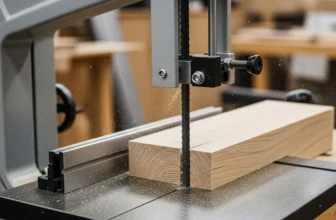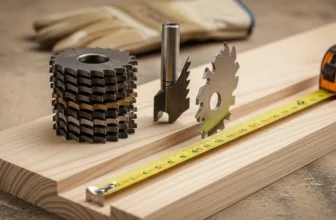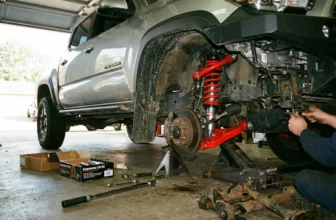DeWalt XR vs. FlexVolt: Which Battery System is Best for Your Tools?
When investing in cordless power tools, choosing the right battery platform is critical, and for many, that means selecting between DeWalt XR and DeWalt FlexVolt.
DeWalt has earned the trust of contractors and homeowners worldwide for its reliability and performance. However, your decision on the battery system directly impacts tool compatibility, runtime, and power output. This choice determines if your setup is suited for heavy-duty professional demands or more manageable DIY tasks, influencing your overall work efficiency and future upgrade costs.
The debate between the two popular platforms—XR and FlexVolt—is a crucial one. We will first provide a detailed understanding of the DeWalt XR system: what it offers, who it’s best suited for, and why it remains one of the most popular 20V cordless lines on the market.
Overview of DeWalt XR
The DeWalt XR lineup stands for “eXtreme Runtime.” Introduced as an upgrade to the standard 20V Max battery system, XR tools and batteries are engineered to deliver better energy efficiency, longer runtime per charge, and improved tool performance.
What Does XR Mean?
- XR = Extended Runtime
- XR tools use brushless motors, which reduce friction and heat.
- XR batteries are designed to last longer per charge compared to standard 20V Max packs.
In simple terms, XR provides:
✔ Longer battery life
✔ More power efficiency
✔ Better durability in professional environments
This makes XR a favorite for both homeowners and working tradespeople.
Battery Technology Behind DeWalt XR
The DeWalt XR system uses 20-volt lithium-ion batteries that come in various capacities. These typically range from 2.0Ah, 4.0Ah, 5.0Ah, 6.0Ah, 8.0Ah, and up to 10.0Ah. The key advantage of higher amp-hour batteries is that they store more energy, allowing you to work longer before needing a recharge.
- A 2.0Ah battery is ideal for lightweight tasks.
- A 5.0Ah battery is a balanced, general-purpose option.
- A 10.0Ah battery delivers long runtime for pros who work continuously.
XR batteries are also backward compatible with DeWalt’s full 20V Max tool range. This means if you already own a basic DeWalt drill or driver, upgrading to XR is easy—just start using XR batteries.
Which Tools Use DeWalt XR?
DeWalt XR powers a wide variety of 20V Max cordless tools, including:
| Tool Type | Examples |
| Drills & Drivers | Impact drivers, hammer drills, drill/drivers |
| Saws | Circular saws, jigsaws, reciprocating saws, miter saws (compact) |
| Outdoor Tools | String trimmers, blowers, hedge trimmers |
| Specialty Tools | Sanders, grinders, nailers, oscillating tools |
This wide tool ecosystem is one of the biggest advantages of the XR line if you’re invested in XR, you have access to dozens of high-performing tools without switching battery platforms.
Why DeWalt XR Is Popular Among Homeowners and Professionals
The XR system strikes an excellent balance between:
- Power
- Battery efficiency
- Tool weight
- Affordability
Most XR tools are lightweight and portable, making them easy to use for day-to-day carpentry, repairs, woodworking, renovations, and general construction tasks. While they may not deliver the raw power of FlexVolt (which we will cover in Step 2), XR tools offer more than enough strength for medium-duty and even some heavy-duty applications.
Key Advantages of DeWalt XR
| Benefit | Explanation |
| Efficient Brushless Motors | Less heat, longer lifespan, better power delivery |
| Longer Runtime | Designed for productivity without frequent recharges |
| Large Tool Ecosystem | Works with dozens of 20V Max tools |
| Lightweight & Ergonomic | Less fatigue during long working sessions |
| Cost-Effective | More budget-friendly compared to FlexVolt |
Who Is DeWalt XR Best For?
| User Type | Why XR Fits Their Needs |
| DIY Homeowners | Easy to use, affordable, reliable performance |
| Woodworkers | Smooth power delivery for precision tasks |
| General Contractors | Portable and versatile tool choices |
| Electricians & Plumbers | Compact tools suitable for daily jobsite work |
Overall, if you want a balanced, efficient power tool system that works for most professional and home projects, DeWalt XR is a strong choice.
Overview of DeWalt FlexVolt
While the DeWalt XR system focuses on efficiency and runtime, DeWalt FlexVolt was created to push the boundaries of raw power and versatility. Introduced in 2016, the FlexVolt platform is DeWalt’s answer to professionals who demand corded-level power in cordless tools.
The secret behind its innovation lies in adaptive voltage technology—a revolutionary feature that allows a single battery to automatically change voltage depending on the tool it’s connected to.
What Makes DeWalt FlexVolt Special?
FlexVolt batteries are dual-voltage:
- They run at 20V Max for standard tools, and
- Automatically switch to 60V Max when attached to high-power FlexVolt tools.
For example, the same 9.0Ah FlexVolt battery can deliver:
- 9.0Ah at 20V (for smaller tools)
- 3.0Ah at 60V (for larger tools like table saws or grinders)
This innovation gives users unmatched flexibility—you can power everything from a cordless drill to a full-size circular saw with the same battery pack.
Battery Technology Behind DeWalt FlexVolt
DeWalt FlexVolt batteries feature 15 lithium-ion cells, compared to the 10 cells found in 20V Max packs. These extra cells allow the battery to operate at higher voltage, translating to more wattage and torque.
FlexVolt batteries are available in various capacities:
- 6.0Ah (2.0Ah at 60V)
- 9.0Ah (3.0Ah at 60V)
- 12.0Ah (4.0Ah at 60V)
The 12.0Ah FlexVolt battery is among the most powerful cordless tool batteries in the market, capable of powering tools like:
- 12” miter saws
- 7-1/4” circular saws
- Heavy-duty grinders
- Table saws and rotary hammers
This power output allows professionals to cut, grind, and drill faster than ever before without the need for power cords.
Which Tools Use DeWalt FlexVolt?
FlexVolt powers some of DeWalt’s most demanding, professional-grade tools, including:
| Category | Example Tools |
| Saws | FlexVolt 60V MAX 7-1/4” circular saw, miter saw, table saw |
| Grinders | 60V MAX brushless angle grinder |
| Demolition Tools | 60V MAX SDS Max rotary hammer |
| Outdoor Equipment | 60V MAX blower, chainsaw, trimmer |
| Combo Kits | 60V MAX FlexVolt drill + saw bundles |
FlexVolt tools are primarily aimed at contractors, framers, roofers, and remodelers who require the same strength as corded tools—but with cordless convenience.
Key Differences: DeWalt XR vs FlexVolt
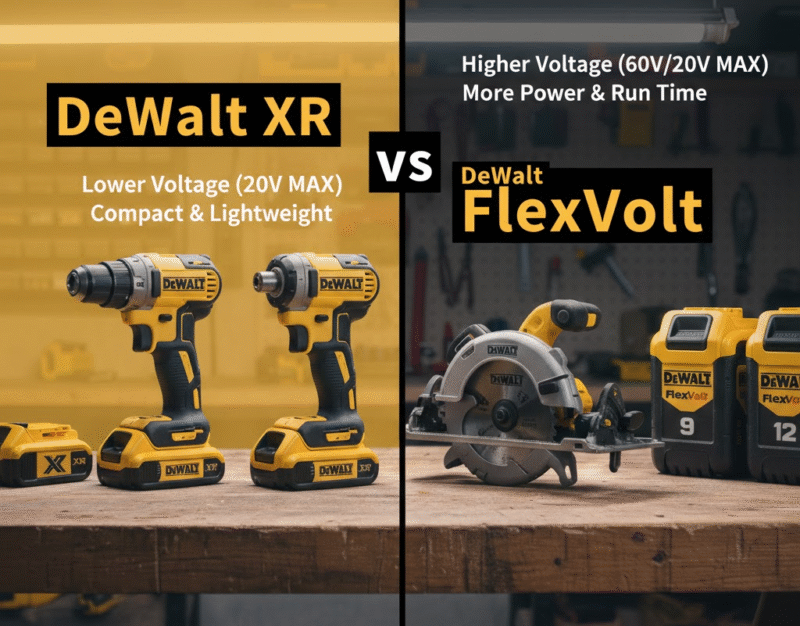
Let’s now break down the core differences between XR and FlexVolt across all important metrics: power, runtime, compatibility, price, and target users.
| Feature | DeWalt XR (20V Max XR) | DeWalt FlexVolt (20V/60V Max) |
| Voltage | 20V Max | 20V / 60V Dual Voltage |
| Power Output | Excellent for light to medium-duty tasks | Superior — handles the most demanding jobs |
| Runtime | Long runtime due to brushless efficiency | Slightly less runtime, but far higher power draw |
| Battery Compatibility | Works with all 20V Max and XR tools | Works with 20V Max and 60V FlexVolt tools |
| Battery Weight | Lighter and more compact | Heavier due to more cells |
| Tool Range | Over 200+ compact and mid-size tools | 60V heavy-duty and high-performance tools |
| Price Range | More affordable | Higher cost (premium platform) |
| Ideal For | DIYers, homeowners, general contractors | Professionals and industrial users |
| Performance Level | Balanced and efficient | Extreme performance and power |
| Innovation Highlight | Brushless XR motors | Dual-voltage adaptive battery tech |
Power Output and Torque
- DeWalt XR: Provides consistent power output that’s perfect for repetitive drilling, fastening, and cutting tasks. The brushless motors deliver high torque but maintain efficiency.
- DeWalt FlexVolt: Produces 50–100% more power, depending on the tool. It can easily match the performance of corded 15-amp tools. For example, a FlexVolt circular saw can rip through thick lumber as quickly as a corded model.
Winner: FlexVolt for raw power, XR for efficiency and control.
Battery Life and Runtime
This comparison depends heavily on what kind of work you’re doing.
- XR batteries have excellent runtime because they are optimized for energy efficiency. They’re ideal for continuous use in smaller tools like drills or impact drivers.
- FlexVolt batteries, while powerful, tend to drain faster when used in 60V mode due to the higher energy draw. However, their high amp-hour capacity (9Ah–12Ah) offsets that to some extent.
Winner: XR for runtime efficiency; FlexVolt for high-demand jobs that need more energy bursts.
Compatibility and Ecosystem
DeWalt has done a great job ensuring cross-compatibility between platforms.
- XR batteries work with any 20V Max tool.
- FlexVolt batteries work with both 20V Max and 60V FlexVolt tools, making them extremely versatile.
However, 20V XR batteries cannot power 60V FlexVolt tools, so if you plan to upgrade later, it might make sense to start with the FlexVolt ecosystem.
Winner: FlexVolt (due to backward compatibility with 20V Max tools)
Weight and Ergonomics
FlexVolt batteries are larger and heavier, which can make smaller tools feel off-balance. On the other hand, XR batteries are lightweight, keeping tools compact and comfortable during extended use.
If you work overhead, or frequently carry tools around a jobsite, XR may be a better ergonomic fit.
Winner: XR (lighter and easier to handle)
Price and Value
The FlexVolt lineup is more expensive across the board—both tools and batteries. You’re paying for higher voltage, dual-voltage capability, and premium-level performance.
However, for professionals who rely on heavy-duty cutting and grinding, this added cost is easily justified.
The XR line remains the best value-for-money option for general use, providing great durability at a reasonable price point.
Winner: XR (for affordability); FlexVolt (for professional ROI)
Performance in Real-World Applications
Let’s see how each system performs in real jobsite scenarios.
Light to Medium-Duty Work (DIY, Home Improvement, Maintenance)
When you’re installing shelves, assembling furniture, or driving screws into drywall, you don’t need maximum torque—you need runtime, control, and convenience.
Here, DeWalt XR tools shine. The compact design and lightweight build make them easier to handle, and the XR batteries ensure long runtime for projects that last several hours.
For most DIYers, homeowners, and maintenance workers, XR is more than enough. It’s powerful, efficient, and versatile.
Heavy-Duty Construction and Industrial Use
Tasks like cutting 4×4 lumber, framing houses, or drilling into concrete require high voltage and torque.
That’s where DeWalt FlexVolt dominates. The 60V Max circular saw or SDS Max rotary hammer can deliver corded-tool performance—without cords. The dual-voltage batteries also make it easy to switch from light tools to heavy machinery with no interruptions.
Contractors, builders, and remodelers benefit from FlexVolt’s power, speed, and durability, especially in environments without easy access to electricity.
Outdoor and Jobsite Work
For outdoor tools like chainsaws, trimmers, and blowers, FlexVolt provides long-lasting, high-energy output, which translates into cleaner cuts and more productivity.
However, if you just need to trim hedges or maintain your yard, the XR 20V outdoor series remains an efficient and cost-effective option.
Which Performs Better Overall?
It depends on your workflow:
| Task Type | Best System | Reason |
| Light carpentry, repairs | XR | Efficient, lightweight, great runtime |
| Framing, cutting large boards | FlexVolt | More power and torque |
| Plumbing, electrical, maintenance | XR | Compact and easy to maneuver |
| Concrete drilling, demolition | FlexVolt | Cordless but corded-level strength |
| DIY projects, home use | XR | More affordable and efficient |
| Professional construction | FlexVolt | Built for maximum performance |
Pros and Cons: DeWalt XR vs FlexVolt
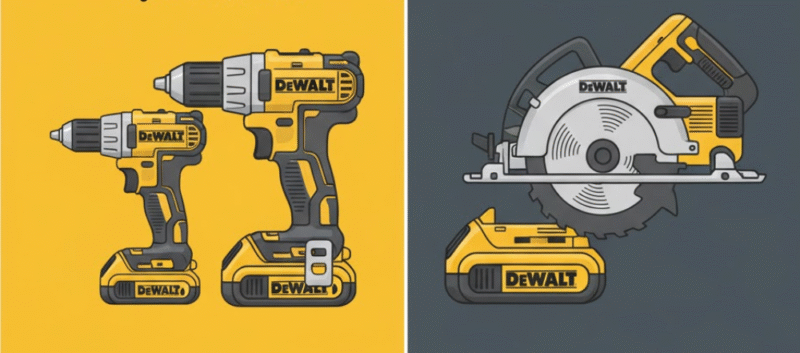
To make things clearer, here is a side-by-side comparison table summarizing the strengths and limitations of each system:
| Feature | DeWalt XR (20V Max XR) | DeWalt FlexVolt (20V/60V Max) |
| Power Level | Medium to High (suitable for most tools) | Very High (designed for heavy-duty applications) |
| Battery Voltage | 20V Max only | Automatically switches between 20V and 60V |
| Runtime Efficiency | Excellent efficiency for long use | High power draw reduces runtime in 60V mode |
| Tool Weight | Generally lighter and more compact | Heavier due to increased battery cell count |
| Compatibility | Works with all 20V Max XR tools | Works with both 20V Max and FlexVolt tools |
| Ideal Users | DIYers, homeowners, electricians, general contractors | Framers, remodelers, builders, concrete workers |
| Price Range | More affordable and cost-effective | Higher-priced premium lineup |
| Best For | Everyday construction, repairs, woodworking, home improvement | Jobsite crew work, outdoor construction, demolition tasks |
| Main Advantage | Lightweight, long runtime, large ecosystem | Cordless tools with corded-equivalent power |
| Main Trade-Off | Slightly lower max power output | Bigger batteries = heavier tools |
Which One Should You Choose?
Now that the technical and practical differences are clear, the final question remains:
Should you choose DeWalt XR or FlexVolt?
Your choice depends primarily on your work intensity and tool use.
Choose DeWalt XR if:
✔ You need a lightweight, efficient, and versatile tool system
✔ You mostly perform light to medium-duty work
✔ You value comfort, battery life, and portability
✔ You want a more affordable cordless tool platform
✔ You need access to a wide range of tools (drills, drivers, sanders, nailers, etc.)
Best for:
- DIY homeowners
- Electricians
- Plumbers
- Maintenance technicians
- General contractors handling interior finishing work
If you work mostly with small to mid-sized tasks, DeWalt XR offers more than enough performance while keeping tool weight low and costs reasonable.
Choose DeWalt FlexVolt if:
✔ You need maximum power, torque, and cutting strength
✔ You frequently work with large lumber, concrete, steel, or masonry
✔ You want cordless tools that perform like corded 15-amp tools
✔ You’re okay with heavier tools and higher battery cost
✔ You want dual-voltage convenience between 20V and 60V tools
Best for:
- Carpenters and framers
- Roof installers
- Remodelers and contractors
- Concrete, metal, and masonry workers
- Outdoor construction professionals
If your work demands high performance and muscle, FlexVolt is the platform engineered for your needs.
Recommendation Based on User Type
| User Type | Recommended Platform | Reason |
| Casual DIY Homeowner | DeWalt XR | More affordable, easier to use, lightweight |
| Weekend Woodworker | DeWalt XR | Great runtime and precision for shop projects |
| Electrician / Plumber | DeWalt XR | Compact cordless performance and portability |
| Full-Time Contractor | Mix of XR + FlexVolt | XR for routine tasks, FlexVolt for demanding duties |
| Framer / Roofer / Builder | FlexVolt | High power for saws and heavy construction |
| Concrete / Masonry Worker | FlexVolt | Needed for SDS hammers and demolition tools |
Pro Tip:
Many professionals actually use both systems together.
They run smaller XR tools for finishing work and switch to FlexVolt for heavy-duty sawing, grinding, and drilling.
Conclusion: DeWalt XR vs FlexVolt — Which Is Better?
When comparing DeWalt XR vs FlexVolt, the right choice depends on how you work, where you work, and the type of tools you rely on.
- DeWalt XR is ideal for those who value efficiency, long battery life, portability, and affordability. It’s a fantastic all-purpose system suitable for most household, workshop, and professional tasks.
- DeWalt FlexVolt, on the other hand, is designed for maximum power, making it perfect for heavy construction, framing, demolition, and commercial jobsite applications. It brings the performance of corded tools into the cordless world, providing unmatched cutting and drilling strength.
If you’re a DIYer or general contractor handling normal workloads, XR is the best fit.
If you’re a professional who frequently works with large materials or heavy-duty tools, FlexVolt is the superior investment.
Hi, I’m Charles Larson. We do everything we can to support our readers with hundreds of hours of research and comparison testing to ensure you find the perfect tool for your workshop.



